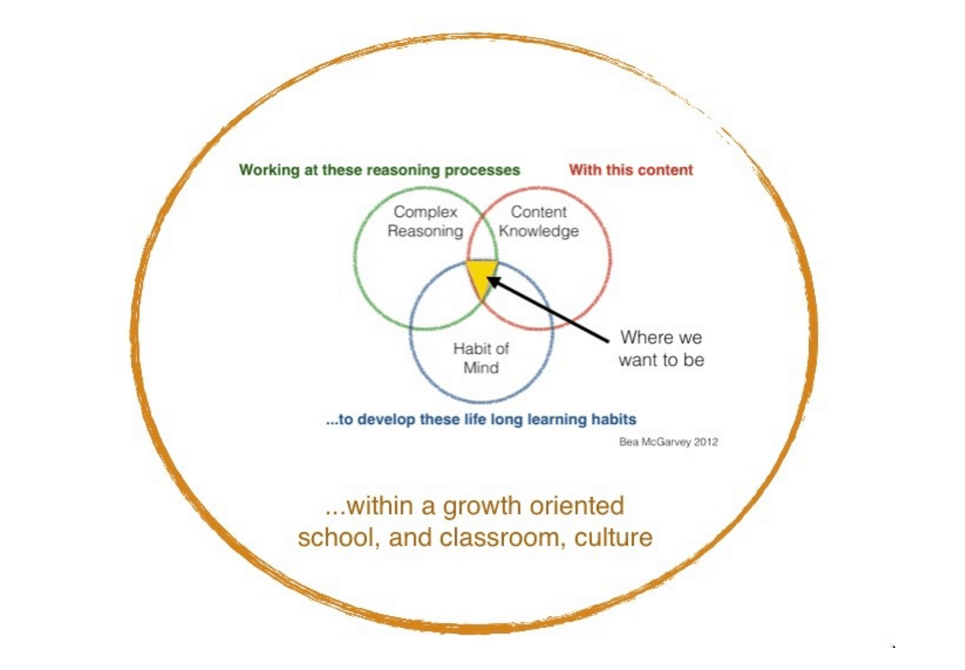What Is The Foundation of Personalized Learning?

By Courtney Belolan
This blog originally ran on CompetencyWorks.
The biggest piece of advice I can give to any teacher, school or district working toward a vision of personalized learning is this:
Learning community culture is the foundation of personalized learning.
For many reasons, this vital piece is often overlooked and rarely focused on in professional development. Districts focus on the more easily measured elements of teacher evaluation models, which speak more to specific instructional strategies and behaviors. Teachers feel pressure to “get to the content” quickly at the start of the year. Performance and production are valued over process.
The truth is that even the most carefully tuned proficiency-based system will crumble without a cultivated culture of learning.
Teachers and learners will hit a wall of frustration as they try to implement personalized learning of any kind. In order for learner-centered proficiency-based systems to work, the learning community culture needs to nurture and sustain the following elements:
1. Voice: The intentional inclusion of all learning community members in decision making in school and classroom environments.
Looks Like: Students setting up the classroom with the teacher; students creating and sustaining a code of cooperation; teachers at the planning table for school and district professional development; parents and students on a principal’s cabinet.
Sounds Like: People asking the opinions of others; questions welcomed; intentional discussions; stopping a decision in order to get all stakeholder input; explaining decisions; accepting and supporting the outcome of decisions.
2. Independence and Autonomy: The ability to function within the learning community by thinking and acting on one’s own, which grows into and enables the intentional shifting and re-balancing of decision making power and control among learning community members.
Looks Like: Students working on their own while teachers confer or hold small groups; teacher teams creating and changing schedules as needed; students setting goals about what work to do when; teachers making time for planning by sharing time and students as they need.
Sounds Like: A team meeting to adjust the weekly schedule to support a project; students checking in with an advisor to plan course selections; students quietly chatting with a partner about their reading, then picking up a new book instead of going to the teacher.
3. Growth: The valuing of continuous, honest reflection on and development of knowledge and skills.
Looks Like: students and teachers using learning progressions, students knowing where they are on learning progressions and knowing what to do to grow, teachers setting goals for professional growth based on a professional learning progression, students and teachers reflecting after learning opportunities.
Sounds Like: talking about what students can do or will be able to do, teachers talking with other teachers to learn about practices, avoiding the word “can’t” and including the word “yet.”
These elements support personalized learning at all levels of the learning community, from the classroom to the district. Of course, there are many different practices and tools that support this kind of collaborative culture and will take different forms depending on a variety of factors, including age, style and other learning community characteristics.
Take a moment to imagine your ideas about the ideal learner-centered school. If you had to describe the attitudes and behaviors of that ideal learning community, what would you say? This is the culture you need to cultivate. These resources can inform your cultivation.
Training:
Reinventing Schools Coalition
Books:
A Reason To Teach by James Bean
Learners Rule by Bill Zima
Drive by Daniel Pink
Mindset by Carol Dweck
Unsustainable by Tim R. McDonald
Articles and Blogs:
A Democratic Approach To Classroom Management, ASCD
Carol Dweck Revisits the Growth Mindset, Education Week
Whose Classroom Is This? Competency Works
Creating A Classroom Parking Lot, Competency Works
A Learning Progression To Support Teachers, Competency Works
For more, see:


0 Comments
Leave a Comment
Your email address will not be published. All fields are required.